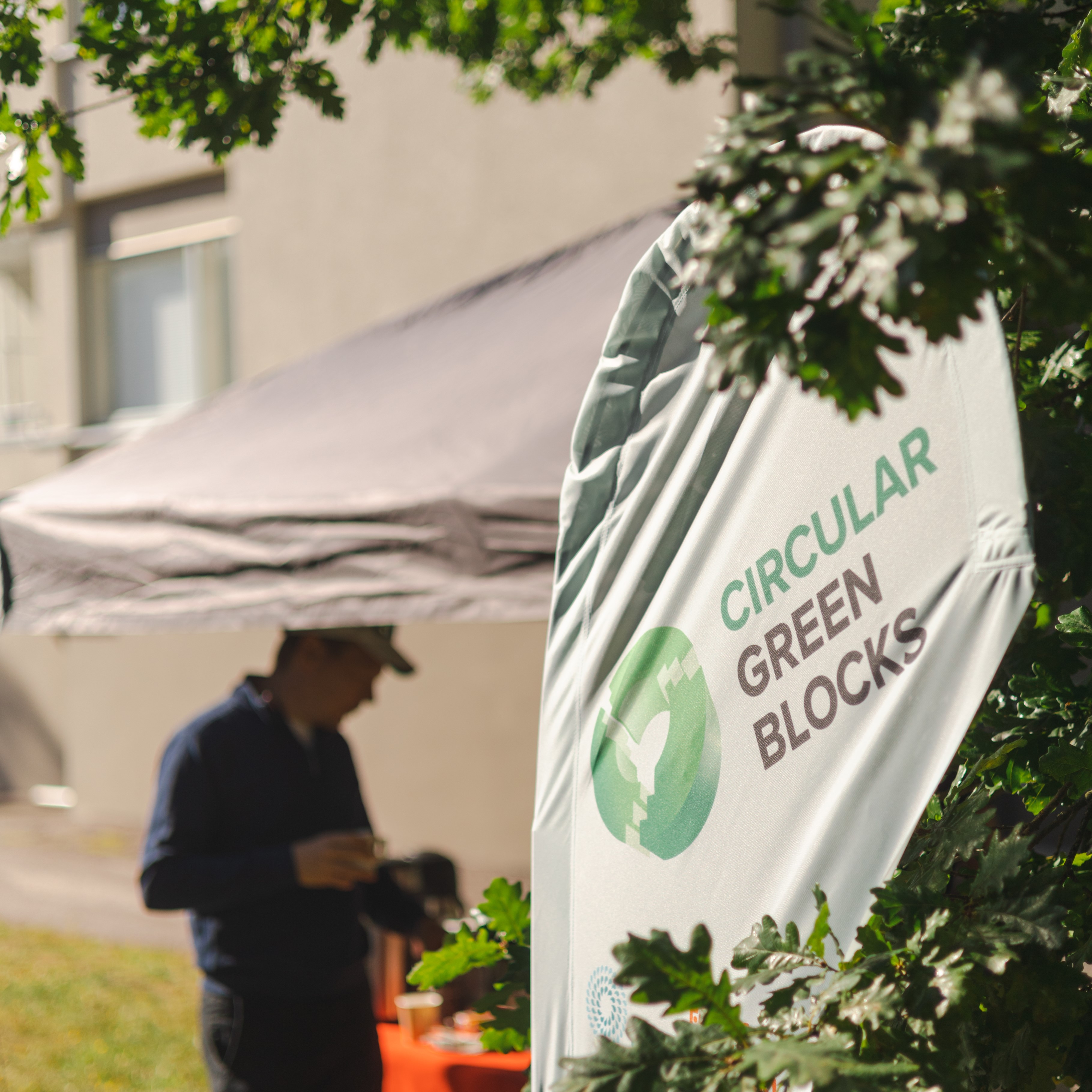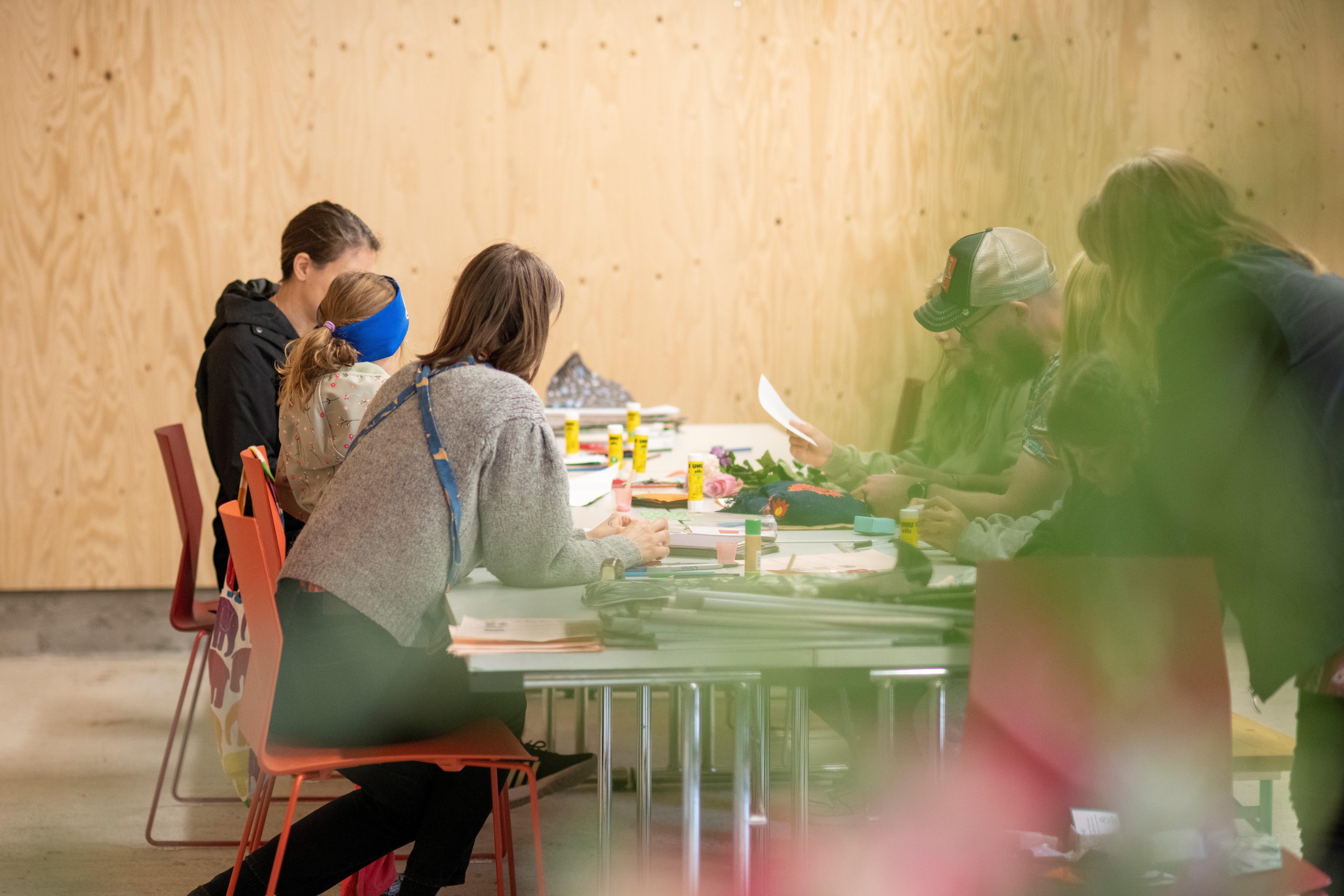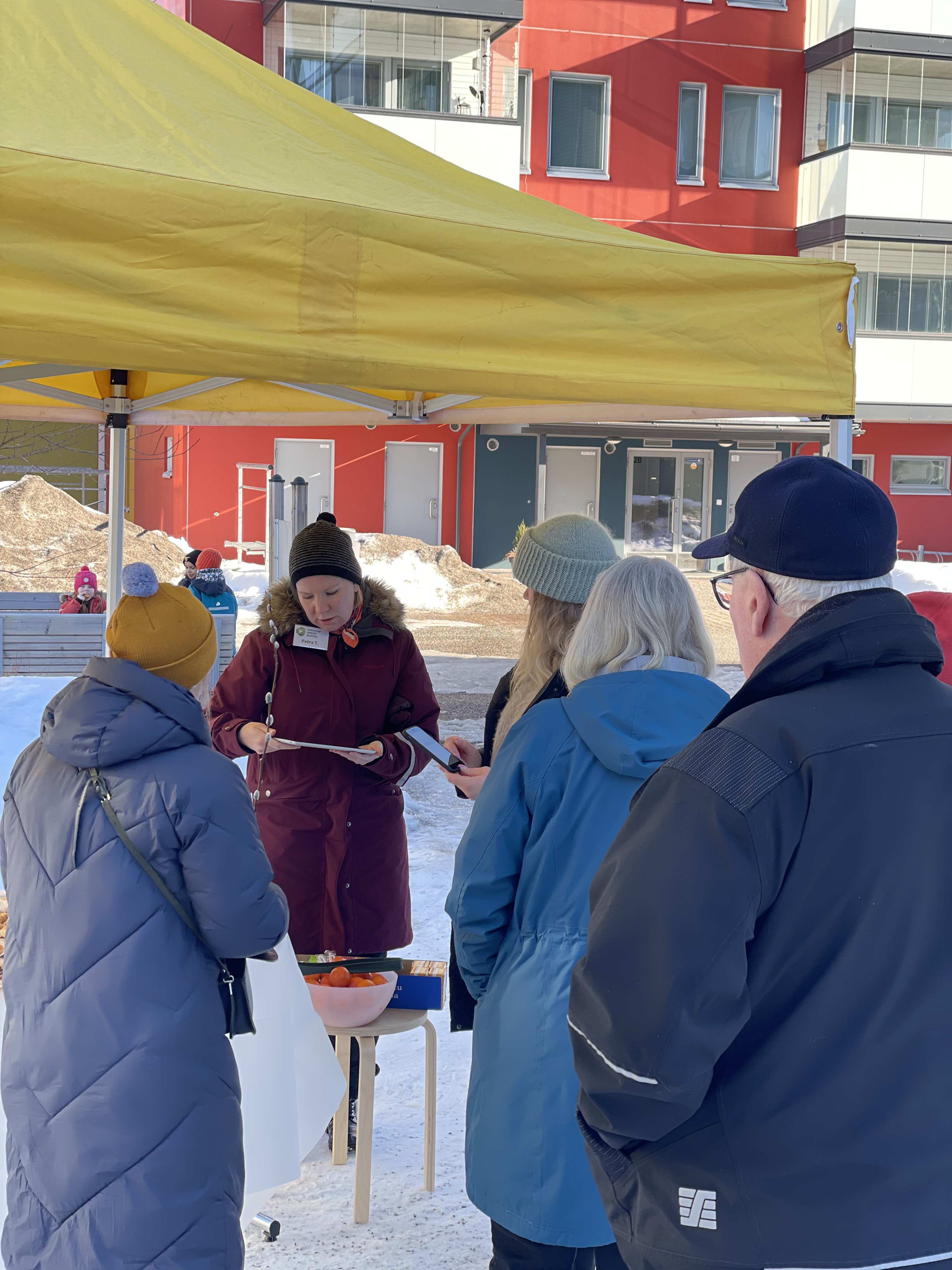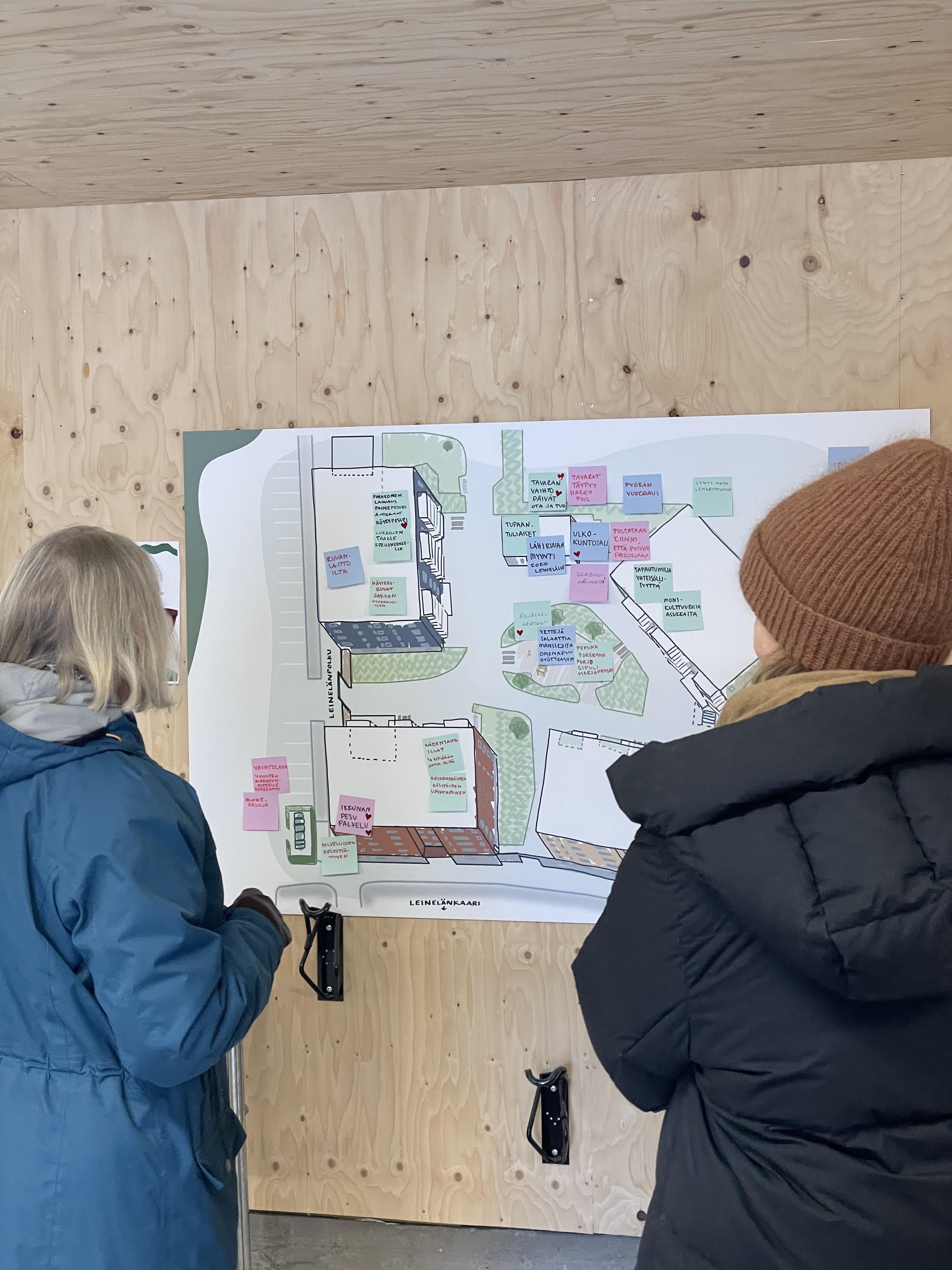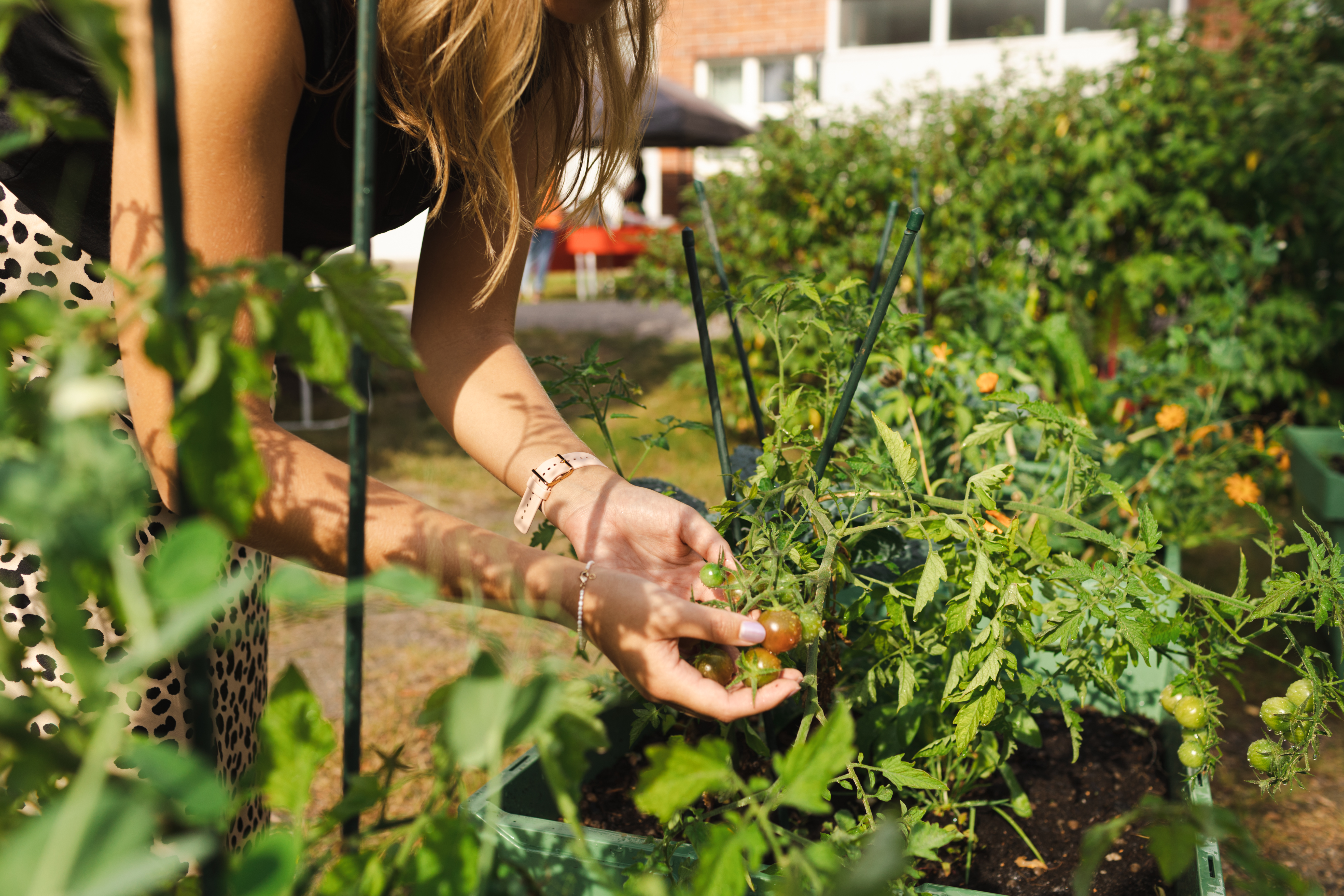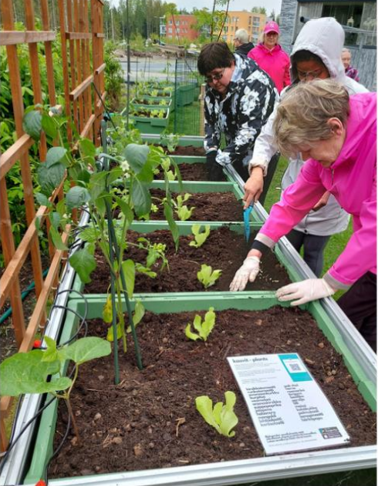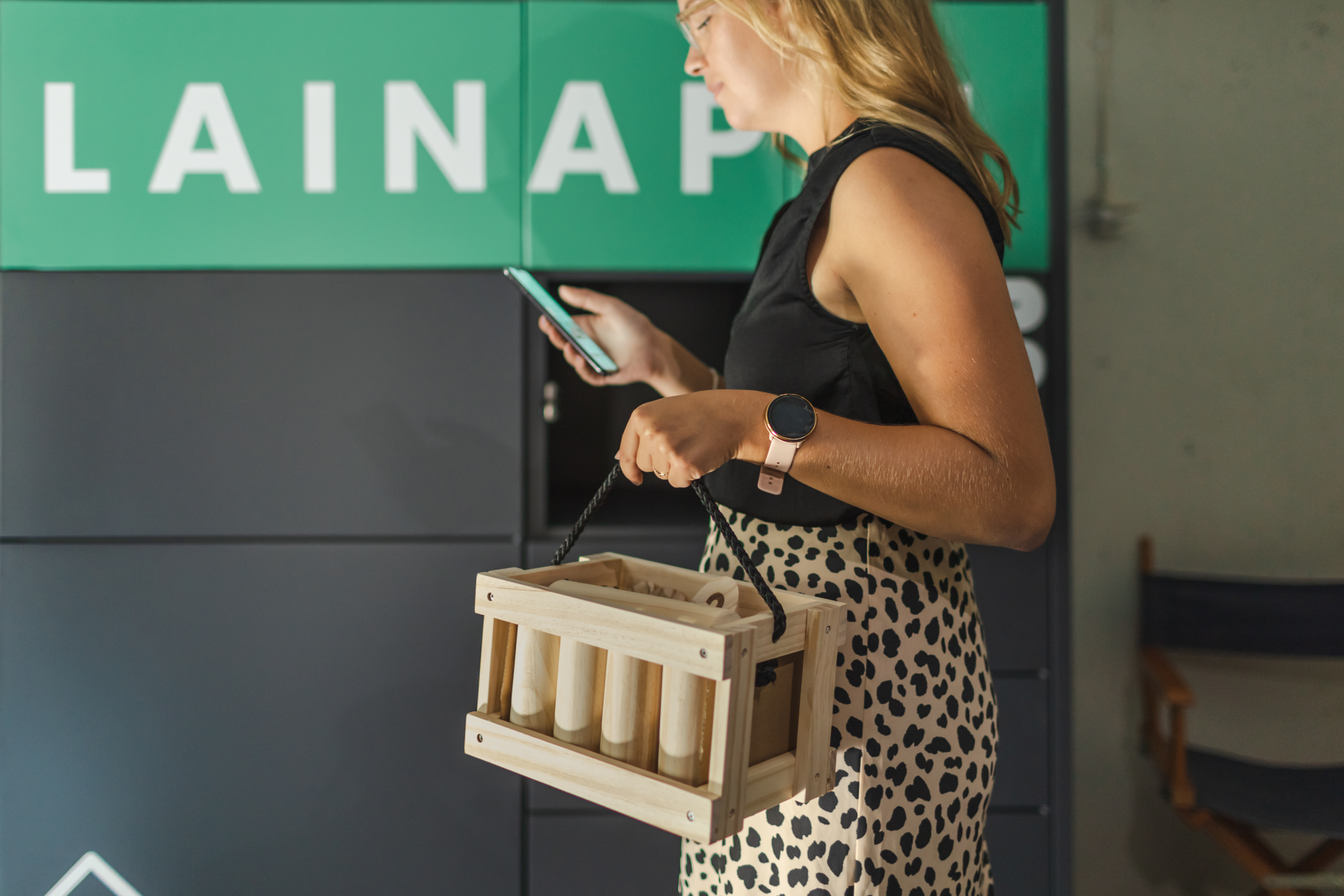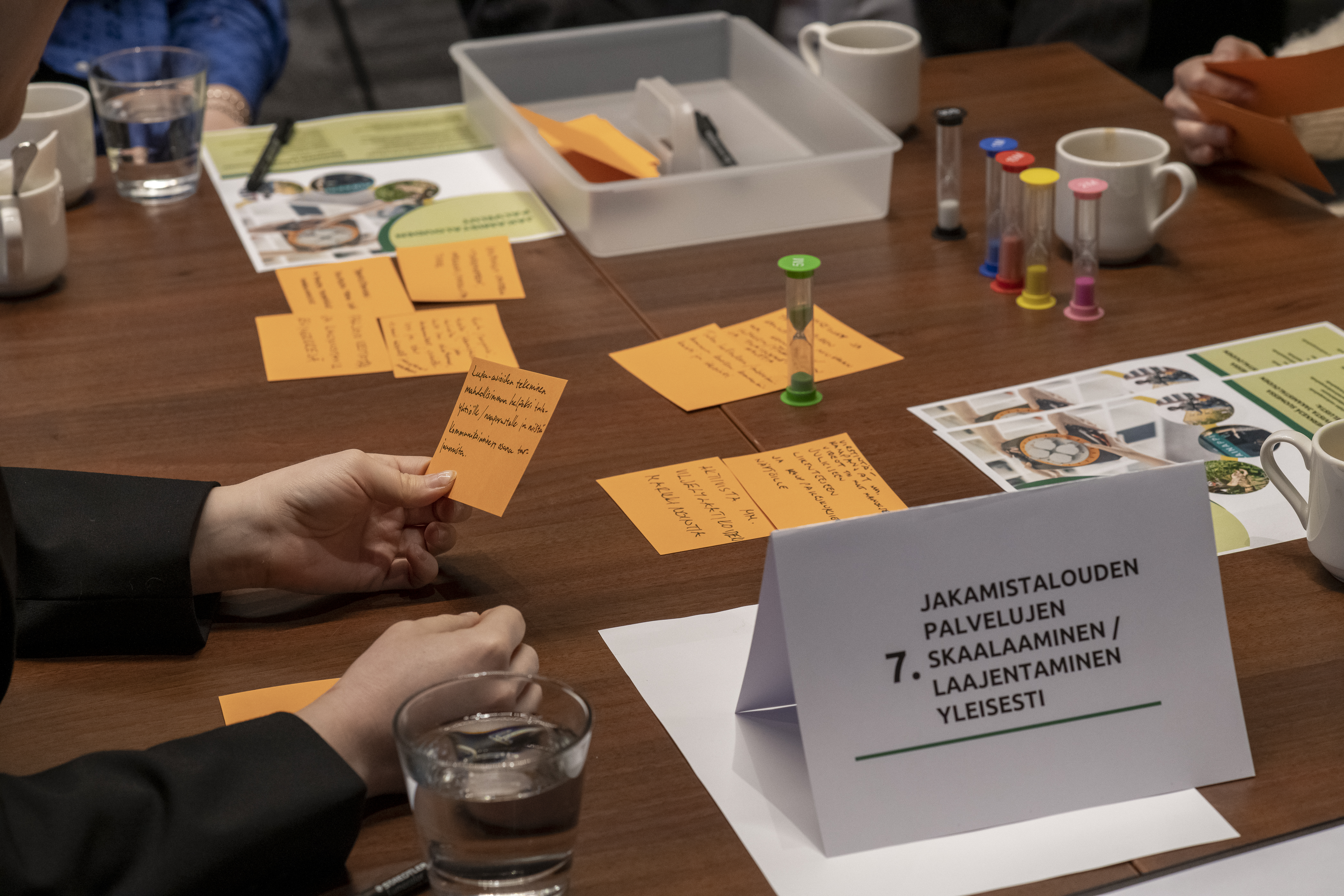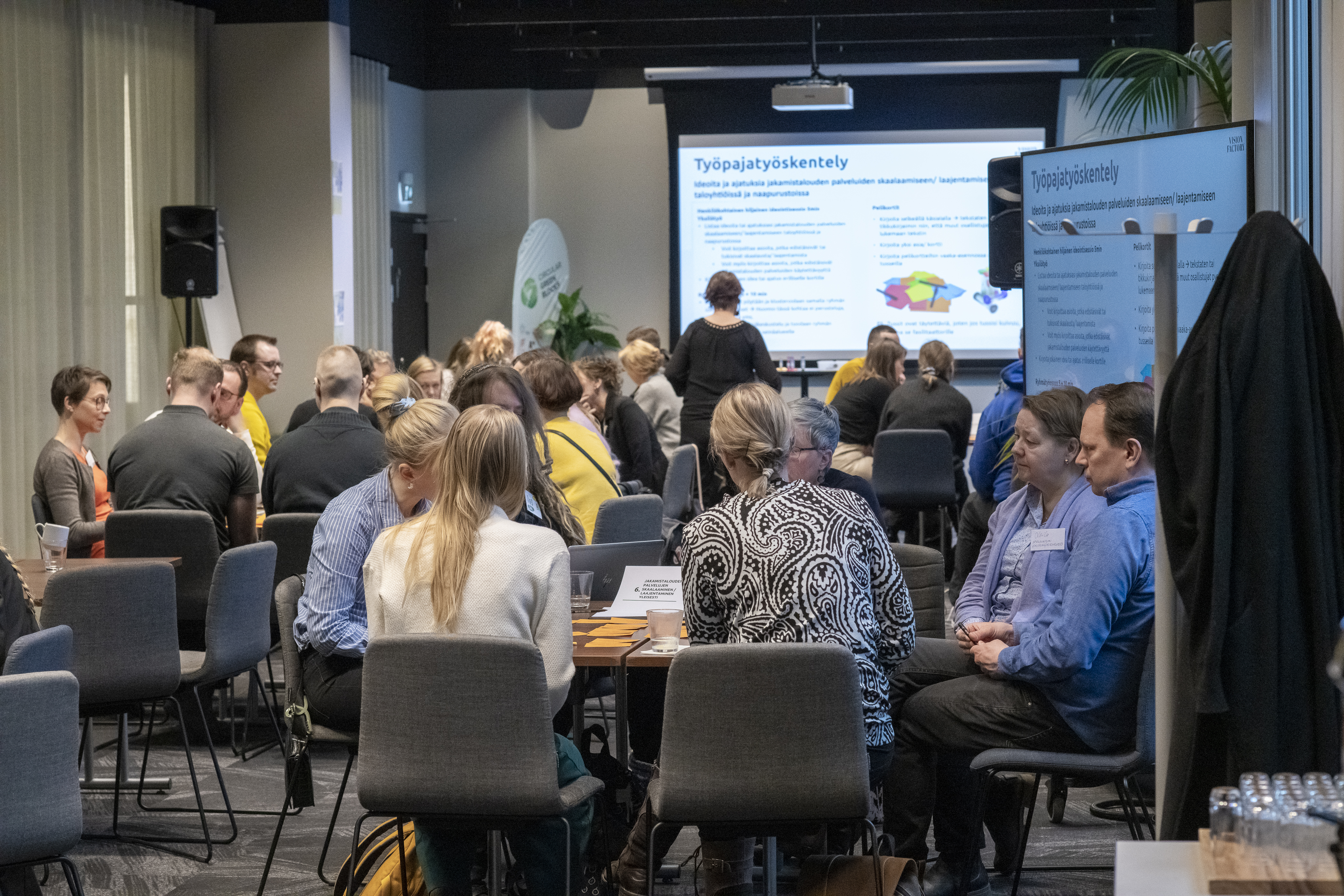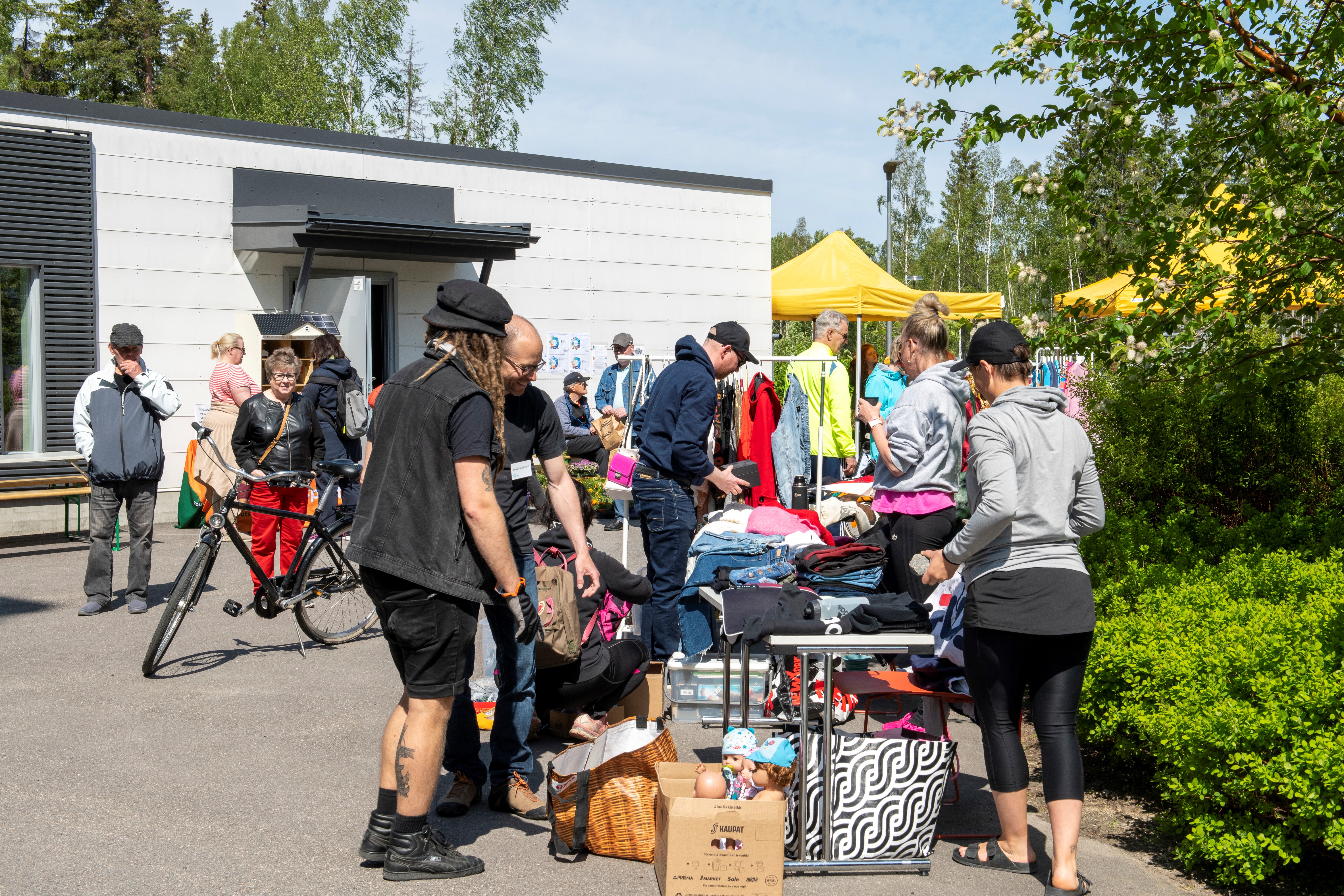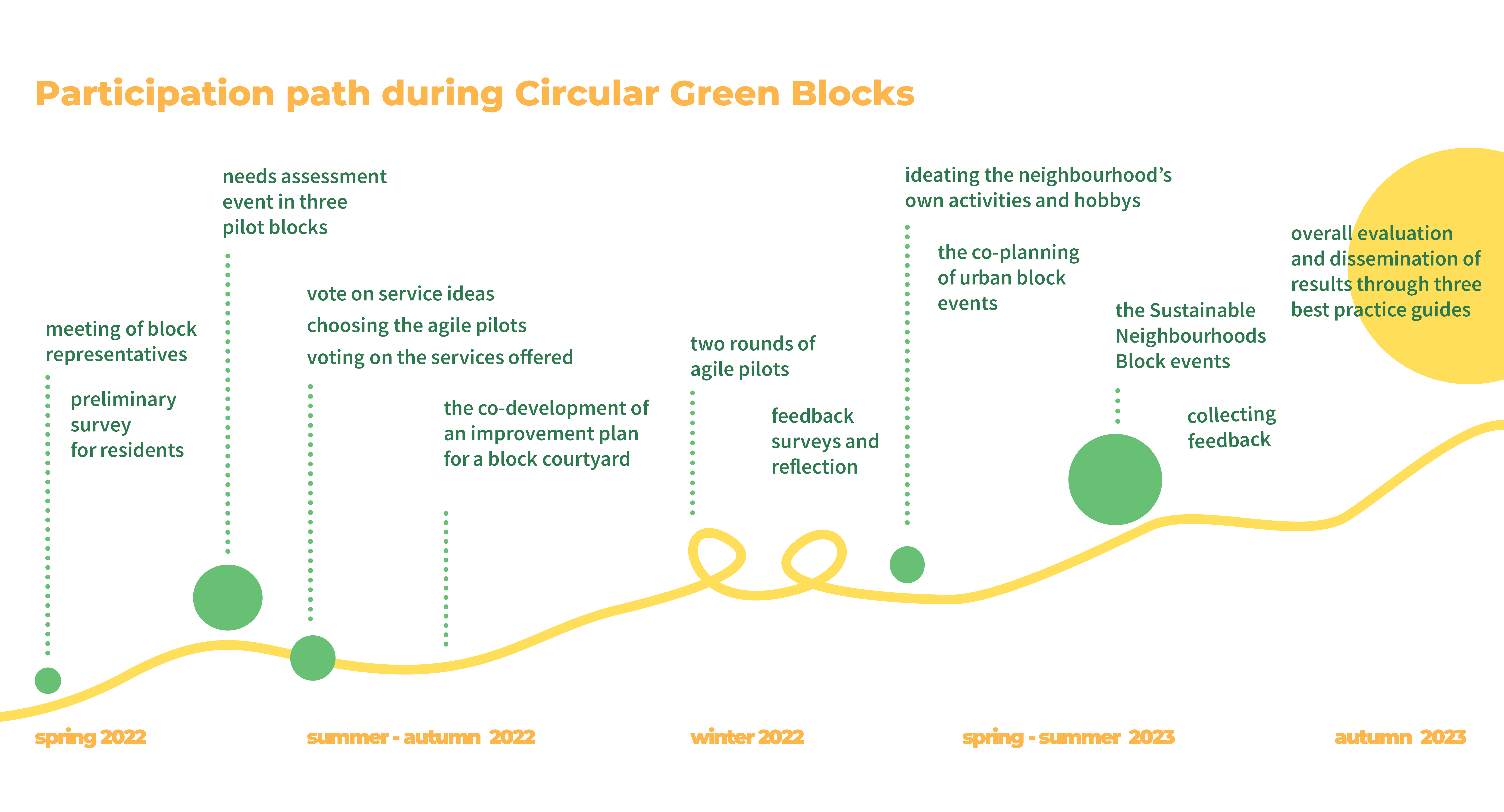Regaining a sense of belonging
Circular Green Blocks
Sustainable city quarters as circular economy business promoters
The change begins in the urban block communities! Turning sustainability transition into an everyday action calls for co-design between residents, businesses and public authorities. Circular Green Blocks focused on tailoring sharing economy solutions for urban blocks, a novel field prominent for new business opportunities. Developing a sharing economy intertwines with community-building and fostering a sense of belonging in the neighbourhoods as it builds on trust and sharing with the community.
EU Member State, Western Balkans or Ukraine
Finland
Local
Helsinki, Espoo, Vantaa (Finland)
No
No
Mainly urban
It refers to other types of transformations (soft investment)
Yes
2023-09-30
Yes
ERDF : European Regional Development Fund
No
No
As a representative of an organisation, in partnership with other organisations
Circular Green Blocks focused on sharing economy pilots to transform neighbourhoods into more sustainable, innovative and inclusive communities for a greener future. The project tailored, tested and promoted sharing services at the block level through collaboration between green growth companies and service users. Fostering a sharing economy interlinks closely with local community-building and establishing trust that also enhances the sense of belonging in the neighbourhood as residents gain agency in their living environments.
Four pilot blocks were targeted as living co-design labs of the sharing economy and three for shorter agile pilots. The selected blocks varied in age and setting within the urban fabric, encompassing both rented and privately owned properties.
Commenced with a thorough mapping of the residents' needs and available facilities in the pilot blocks was followed by an agile piloting programme. It delved into shared mobility solutions, urban gardening, landscape design and initiatives to strengthen the local community. Conducted ten pilots, including e-bikes as a service, storage solutions for electric cargo bikes, landscaping of multi-purpose storage containers, urban gardening services, shared mushroom gardens and developing digital platforms for neighbourly support.
The co-development with residents continued throughout the project and boosted their agency and ownership over the developed results. The regenerative process reportedly contributed to their sense of belonging and activated new people to join events and co-ideation. Resident-initiated activities demonstrate a cultural change, active participation and a sense of ownership to shape future ambitions.
The project contributed to a more sustainable and connected urban environment through its activities. Insights from the project are compiled into three guides to inform future actions while several of the initiated actions already continue to thrive in the pilot blocks.
Four pilot blocks were targeted as living co-design labs of the sharing economy and three for shorter agile pilots. The selected blocks varied in age and setting within the urban fabric, encompassing both rented and privately owned properties.
Commenced with a thorough mapping of the residents' needs and available facilities in the pilot blocks was followed by an agile piloting programme. It delved into shared mobility solutions, urban gardening, landscape design and initiatives to strengthen the local community. Conducted ten pilots, including e-bikes as a service, storage solutions for electric cargo bikes, landscaping of multi-purpose storage containers, urban gardening services, shared mushroom gardens and developing digital platforms for neighbourly support.
The co-development with residents continued throughout the project and boosted their agency and ownership over the developed results. The regenerative process reportedly contributed to their sense of belonging and activated new people to join events and co-ideation. Resident-initiated activities demonstrate a cultural change, active participation and a sense of ownership to shape future ambitions.
The project contributed to a more sustainable and connected urban environment through its activities. Insights from the project are compiled into three guides to inform future actions while several of the initiated actions already continue to thrive in the pilot blocks.
sustainable neighbourhoods
sharing economy
agile piloting
co-creation
community building
Circular Green Blocks focused on increasing sustainability through a holistic approach that promotes circular and sharing economy practices at the city block level. Key objectives included identifying and developing circular and sharing economy business opportunities in residential blocks and assisting housing associations in implementing circular economy solutions.
Optimising the use of existing facilities was a key part of the project, which carried out a space and needs assessment for each pilot block, identifying under-utilised spaces and potential areas for improvement. By repurposing existing resources, such as common areas or outdoor spaces on the block premises, the project minimised the environmental impact. It also actively promoted resource efficiency through shared services that were iteratively developed with residents and service providers through agile piloting.
The principles of the sharing economy were brought to practice in the ten solutions piloted, ranging from shared electric bicycles to community-based urban gardening. These initiatives highlighted resource efficiency, waste reduction and improved community engagement.
The participatory approach, which engaged residents, housing associations and businesses, supported addressing the community's diverse needs and contributed to the longevity of the services piloted.
Furthermore, 360-degree photography and 3D geospatial data modelling were used to visualise different solutions in the pilot blocks and inspect their impacts on the lighting and rainwater drainage. The collected data also allows change detection over time (e.g. changes in the greenery through seasons, changes in the block infrastructure and their implications) and virtual placement trials for new facilities.
One aspect of sustainable event organisation was providing only vegetarian and/or vegan food and snacks and avoiding food waste.
Optimising the use of existing facilities was a key part of the project, which carried out a space and needs assessment for each pilot block, identifying under-utilised spaces and potential areas for improvement. By repurposing existing resources, such as common areas or outdoor spaces on the block premises, the project minimised the environmental impact. It also actively promoted resource efficiency through shared services that were iteratively developed with residents and service providers through agile piloting.
The principles of the sharing economy were brought to practice in the ten solutions piloted, ranging from shared electric bicycles to community-based urban gardening. These initiatives highlighted resource efficiency, waste reduction and improved community engagement.
The participatory approach, which engaged residents, housing associations and businesses, supported addressing the community's diverse needs and contributed to the longevity of the services piloted.
Furthermore, 360-degree photography and 3D geospatial data modelling were used to visualise different solutions in the pilot blocks and inspect their impacts on the lighting and rainwater drainage. The collected data also allows change detection over time (e.g. changes in the greenery through seasons, changes in the block infrastructure and their implications) and virtual placement trials for new facilities.
One aspect of sustainable event organisation was providing only vegetarian and/or vegan food and snacks and avoiding food waste.
The aesthetics and quality of the human experience were particularly addressed in the design and co-creation of the piloted services and events, high-quality visual communication and actions for strengthening the sense of community. The project utilised co-design to match the solutions with residents' needs and raise their appeal to residents, thus improving their overall experience.
The regenerative co-development process and Sustainable Neighbourhoods events provided collective experiences for the neighbourhood, allowing them to see their daily living environment in a new light and meaningful interactions through setting a shared vision and taking action.
The project ran a direct and active dialogue to include them in decision-making processes. A recognisable visual identity in all communication throughout the project made it more familiar to the block residents.
The project sought to integrate into residents' daily neighbourhood life. For example, residents of one pilot block set up a dedicated shelf to exchange goods and communal block hobbies (such as a cultural cooking evening, a family baking day, a sewing club, etc.). These activities, initiated alongside the project and at the request of the residents, increased the opportunity to meet other neighbours and enhance the sense of community and belonging through sustainability-related activities.
The aesthetic quality of the piloted solutions was also considered, e.g. with landscaping to create visually attractive and multifunctional environments. The e-cargo bicycle storage container was landscaped, improving its functionality and aesthetics. Urban gardening was piloted as a service in three housing associations, further promoting sensory experiences, a sense of shared responsibility and cooperation among residents. This increased the visual attractiveness of the environment and the local food production and provided an avenue for shared activities and learning.
The regenerative co-development process and Sustainable Neighbourhoods events provided collective experiences for the neighbourhood, allowing them to see their daily living environment in a new light and meaningful interactions through setting a shared vision and taking action.
The project ran a direct and active dialogue to include them in decision-making processes. A recognisable visual identity in all communication throughout the project made it more familiar to the block residents.
The project sought to integrate into residents' daily neighbourhood life. For example, residents of one pilot block set up a dedicated shelf to exchange goods and communal block hobbies (such as a cultural cooking evening, a family baking day, a sewing club, etc.). These activities, initiated alongside the project and at the request of the residents, increased the opportunity to meet other neighbours and enhance the sense of community and belonging through sustainability-related activities.
The aesthetic quality of the piloted solutions was also considered, e.g. with landscaping to create visually attractive and multifunctional environments. The e-cargo bicycle storage container was landscaped, improving its functionality and aesthetics. Urban gardening was piloted as a service in three housing associations, further promoting sensory experiences, a sense of shared responsibility and cooperation among residents. This increased the visual attractiveness of the environment and the local food production and provided an avenue for shared activities and learning.
Circular Green Blocks was designed and implemented with inclusion, accessibility, affordability and design-for-all principles at the core. A joint ideation between the stakeholders (incl. residents) helped to outline the need for service design and development for the block-level transformation.
Our key principle was to ensure equal opportunities for all to participate in the pilots and events, thus contributing to an equal living environment. The project events were designed with a focus on broad participation (e.g. easy access to the venue, activities for different age groups, free participation, multiple ways to participate) and with an emphasis on multi-channel communication and event marketing. Communication tools included a dedicated website, various social media channels, a newsletter, online newsletters, information through stakeholder channels, local newspapers, and traditional communication through posters.
The pilot solutions and events were free of charge to all residents and participants. The events were designed to meet the interests of different age groups: co-designed events encouraged children to participate by providing them interesting activities in the programme. In general, the activities were organised on the premises of the pilot sites: the project team travelled to the participants to facilitate their participation.
The community gardening, small-scale mushroom farm pilots and associated harvest parties were tailored to suit residents of all ages and backgrounds and promoted intergenerational interaction.
The activities boosted opportunities for social interaction, increased the number of participants in the residents' committees and enabled a sense of belonging to grow, which would continue to develop in the block after the project ended.
Our key principle was to ensure equal opportunities for all to participate in the pilots and events, thus contributing to an equal living environment. The project events were designed with a focus on broad participation (e.g. easy access to the venue, activities for different age groups, free participation, multiple ways to participate) and with an emphasis on multi-channel communication and event marketing. Communication tools included a dedicated website, various social media channels, a newsletter, online newsletters, information through stakeholder channels, local newspapers, and traditional communication through posters.
The pilot solutions and events were free of charge to all residents and participants. The events were designed to meet the interests of different age groups: co-designed events encouraged children to participate by providing them interesting activities in the programme. In general, the activities were organised on the premises of the pilot sites: the project team travelled to the participants to facilitate their participation.
The community gardening, small-scale mushroom farm pilots and associated harvest parties were tailored to suit residents of all ages and backgrounds and promoted intergenerational interaction.
The activities boosted opportunities for social interaction, increased the number of participants in the residents' committees and enabled a sense of belonging to grow, which would continue to develop in the block after the project ended.
Circular Green Blocks built upon continuous interaction with stakeholders and utilised several participation methods and low-threshold opportunities to ensure residents' voices were heard. Residents of the different pilot blocks were actively involved in designing the pilots and testing the piloted services, which fostered a sense of ownership and sought to increase community empowerment.
A space and needs assessment in the three pilot blocks allowed the project team to get to know the residents, identify their needs and possible common problems, and gauge their understanding of the circular economy. The findings and observations of the kick-off event were reflected throughout the co-development process, and the choices prioritised in the discussions held with the participants.
The activities resulted in a stronger sense of ownership by residents through, for example, activating a nearly vacant bike storage in a new use as space for block-sharing activity, a recycling shelf, and other sharing economy services. The residents' committee from another pilot block noted the benefits of creating a block garden to be pursued in the future.
The Sustainable Neighbourhoods events piloted as one of the project activities were developed in close cooperation with the residents of the neighbourhoods, the target audience for the events. The design promoted a collaborative and participatory approach to event and urban development, making the pilot more relevant, accessible and sustainable.
The success of the project was linked closely to the active involvement of residents and stakeholders, reflecting a commitment to participatory and community-based urban development.
A space and needs assessment in the three pilot blocks allowed the project team to get to know the residents, identify their needs and possible common problems, and gauge their understanding of the circular economy. The findings and observations of the kick-off event were reflected throughout the co-development process, and the choices prioritised in the discussions held with the participants.
The activities resulted in a stronger sense of ownership by residents through, for example, activating a nearly vacant bike storage in a new use as space for block-sharing activity, a recycling shelf, and other sharing economy services. The residents' committee from another pilot block noted the benefits of creating a block garden to be pursued in the future.
The Sustainable Neighbourhoods events piloted as one of the project activities were developed in close cooperation with the residents of the neighbourhoods, the target audience for the events. The design promoted a collaborative and participatory approach to event and urban development, making the pilot more relevant, accessible and sustainable.
The success of the project was linked closely to the active involvement of residents and stakeholders, reflecting a commitment to participatory and community-based urban development.
The project focused on engaging stakeholders on the local level. The broad involvement of stakeholders facilitated finding solutions to the multifaceted issues related to developing and piloting novel sharing economy services in urban environments.
Rental housing companies and housing associations worked closely with the project team to enable the piloting of the selected sharing economy solutions on the block level. The involvement of housing companies ensured that the proposed innovative solutions were also feasible within the existing infrastructure.
The involved companies brought their sharing economy services to be piloted within the pilot blocks and actively co-developed them with residents and stakeholders. These latest solutions placed Circular Green Blocks at the forefront of innovation in sustainable urban development.
The public authorities were consulted to ensure the pilots complied with legal and regulatory requirements, enhancing their credibility and long-term viability. The cities gained insights into the need for policy development for scaling the initiative.
Facilitated workshops created a dialogue between stakeholders who rarely meet. Residents, administrators and other representatives of housing associations, bodies such as the Finnish Real Estate Federation and businesses brought their valuable expertise to the discussions to develop more effective solutions and service pathways. Workshops and project events provided a forum for discussion and shared envisioning between the parties. Several companies cited the workshops with housing association representatives as one of the best benefits of the pilot.
Involving stakeholders at various levels brought significant added value by fostering collaboration, providing diverse expertise, and ensuring that the project was both innovative and feasible in urban environments.
Rental housing companies and housing associations worked closely with the project team to enable the piloting of the selected sharing economy solutions on the block level. The involvement of housing companies ensured that the proposed innovative solutions were also feasible within the existing infrastructure.
The involved companies brought their sharing economy services to be piloted within the pilot blocks and actively co-developed them with residents and stakeholders. These latest solutions placed Circular Green Blocks at the forefront of innovation in sustainable urban development.
The public authorities were consulted to ensure the pilots complied with legal and regulatory requirements, enhancing their credibility and long-term viability. The cities gained insights into the need for policy development for scaling the initiative.
Facilitated workshops created a dialogue between stakeholders who rarely meet. Residents, administrators and other representatives of housing associations, bodies such as the Finnish Real Estate Federation and businesses brought their valuable expertise to the discussions to develop more effective solutions and service pathways. Workshops and project events provided a forum for discussion and shared envisioning between the parties. Several companies cited the workshops with housing association representatives as one of the best benefits of the pilot.
Involving stakeholders at various levels brought significant added value by fostering collaboration, providing diverse expertise, and ensuring that the project was both innovative and feasible in urban environments.
The diverse backgrounds of the project team contributed to innovative and cutting-edge solutions. The team different disciplines such as urban geography, chemical engineering, design, communication, cultural management, spatial design, environmental philosophy, business development, political science, ITC technology, geoinformatics and 3D geovisualisation. The open co-development processes also engaged residents and stakeholders from diverse backgrounds, ensuring collaborative and sustainable urban development.
The transdisciplinary team had regular meetings and workshops to learn from each other, co-design and co-facilitate the project's progress, and share knowledge within the group. Particularly the beginning of the project involved extensive co-development of the different actions, regular workshops, and meetings. In addition, group members participated in events in the field, which facilitated cross-sectoral exchange of ideas and views beyond the project team.
The collaborative process led to a holistic approach, where the team members had a solution-oriented approach to potential problems. Close cooperation and direct communication helped to correct possible misunderstandings at an early stage.
The team's diverse perspectives and backgrounds allowed for a holistic approach to complex challenges, resulting in pilots for a wide range of applicable solutions building upon transdisciplinary expertise.
Effective communication turned insights into actionable strategies, and user-centred design was used to ensure the sustainability and usability of solutions.
The transdisciplinary team had regular meetings and workshops to learn from each other, co-design and co-facilitate the project's progress, and share knowledge within the group. Particularly the beginning of the project involved extensive co-development of the different actions, regular workshops, and meetings. In addition, group members participated in events in the field, which facilitated cross-sectoral exchange of ideas and views beyond the project team.
The collaborative process led to a holistic approach, where the team members had a solution-oriented approach to potential problems. Close cooperation and direct communication helped to correct possible misunderstandings at an early stage.
The team's diverse perspectives and backgrounds allowed for a holistic approach to complex challenges, resulting in pilots for a wide range of applicable solutions building upon transdisciplinary expertise.
Effective communication turned insights into actionable strategies, and user-centred design was used to ensure the sustainability and usability of solutions.
While circular and sharing economy services are widely available at national and city levels, only a few apply directly to the city block level. As our daily environments, city blocks are essential for meeting CO2 objectives. Seizing new arising business opportunities in this context calls for a better understanding of the target audience and diversity of block contexts. The innovative character of Circular Green Blocks is to focus on this level and facilitate a dialogue between companies and service users. As part of the project, the companies conducted agile piloting on these new market segments (both rental and privately owned premises in the Helsinki region) to test innovative sharing economy services.
Working at the city block level allows for a greater focus on and strengthening the community through the use and development of sharing economy services. For us, resident engagement meant ongoing communication to gather needs, ideas and thoughts with the ambition to foster residents' sense of ownership in sharing economy solutions and their daily environments, which has boosted the continuation of activities even after the project ended.
The project organised sustainable neighbourhood events in close cooperation with residents, resulting in an event model that boosts the adoption of a sharing economy on the neighbourhood level. The event put local outdoor spaces and urban block courtyards to new uses, opening them up for the local community beyond the block residents, enhancing the sense of belonging and enabling the community to see their daily environment in a new light.
Based on the laser scanning technique, the project produced three demonstrations of 3D geospatial data (lighting, stormwater, change detection) as a potential tool to support planning processes and visualise the local environment and its qualities to people with different backgrounds. This introduced a novel approach for using collected 3D data for multiple purposes, saving resources.
Working at the city block level allows for a greater focus on and strengthening the community through the use and development of sharing economy services. For us, resident engagement meant ongoing communication to gather needs, ideas and thoughts with the ambition to foster residents' sense of ownership in sharing economy solutions and their daily environments, which has boosted the continuation of activities even after the project ended.
The project organised sustainable neighbourhood events in close cooperation with residents, resulting in an event model that boosts the adoption of a sharing economy on the neighbourhood level. The event put local outdoor spaces and urban block courtyards to new uses, opening them up for the local community beyond the block residents, enhancing the sense of belonging and enabling the community to see their daily environment in a new light.
Based on the laser scanning technique, the project produced three demonstrations of 3D geospatial data (lighting, stormwater, change detection) as a potential tool to support planning processes and visualise the local environment and its qualities to people with different backgrounds. This introduced a novel approach for using collected 3D data for multiple purposes, saving resources.
The methodology of Circular Green Blocks was based on the principles of participation, open communication, and commitment to enabling participation. The project used an action research approach and sought change through a simultaneous process of research, implementation of co-creation activities and facilitation of pilots.
The project utilised the design thinking process, participatory design and implementation throughout its duration. In particular, the Double Diamond design process by the Design Council was used to encompass the needs assessment of the block and the development of services. The co-development process involved residents and a range of relevant stakeholders. This approach ensured a people-centred approach and that solutions responded to genuine identified needs.
Open and ongoing dialogues were held with residents, housing association representatives and businesses. Co-development, involving all stakeholders in the decision-making process, was used at various project stages.
The project deliberately held events in block courtyards, where the project team was visible and easily accessible, to diminish obstacles to participation. This approach was designed to enable and encourage residents' easy participation, e.g. regardless of their digital skills.
The project used an agile piloting program that allowed for rapid testing and iteration of ideas. The approach proved particularly useful for businesses, allowing them to get direct feedback and improve their products or services.
Project activities strengthened the democratic decision-making in the neighbourhood. Mechanisms such as voting and co-design were used to empower residents to directly influence decisions affecting their daily living environment. The combination of design thinking, agile piloting and fostering neighbourhood democracy contributed to a holistic and participatory approach to sustainable urban development.
The project utilised the design thinking process, participatory design and implementation throughout its duration. In particular, the Double Diamond design process by the Design Council was used to encompass the needs assessment of the block and the development of services. The co-development process involved residents and a range of relevant stakeholders. This approach ensured a people-centred approach and that solutions responded to genuine identified needs.
Open and ongoing dialogues were held with residents, housing association representatives and businesses. Co-development, involving all stakeholders in the decision-making process, was used at various project stages.
The project deliberately held events in block courtyards, where the project team was visible and easily accessible, to diminish obstacles to participation. This approach was designed to enable and encourage residents' easy participation, e.g. regardless of their digital skills.
The project used an agile piloting program that allowed for rapid testing and iteration of ideas. The approach proved particularly useful for businesses, allowing them to get direct feedback and improve their products or services.
Project activities strengthened the democratic decision-making in the neighbourhood. Mechanisms such as voting and co-design were used to empower residents to directly influence decisions affecting their daily living environment. The combination of design thinking, agile piloting and fostering neighbourhood democracy contributed to a holistic and participatory approach to sustainable urban development.
The participatory design process of Circular Green Blocks that integrates sharing economy solutions to the urban block level could be adapted to different European contexts.
The Forum Virium Helsinki's agile pilot process utilised to test sharing economy service in neighbourhoods in partnership with residents and businesses, can be applied in a broad variety of contexts. Replication of the model may require finding an actor among local municipalities, regional councils or other relevant bodies to implement and facilitate similar programmes.
The pilots implemented by the project, which are at different stages of maturity, provide insights into the challenges and opportunities of scaling up.
The idea of a Sustainable Neighbourhoods block event designed for local neighbourhoods can provide a valuable framework that can be disseminated to other communities. Lessons learned from the organisation and implementation of such events can guide the replication of successful community initiatives, raise awareness of the circular economy and increase residents' sense of belonging to their neighbourhoods.
Transferability and successful replicability of these solutions reguires a considered assessment of local needs, an understanding of the regulatory framework and the active involvement of stakeholders. Building partnerships with local authorities and community representatives is essential to adapt and effectively implement these models in different locations.
The project's experience, methodology and collaborative approaches can provide valuable lessons for those wishing to launch similar sustainable urban development initiatives in different contexts.
The Forum Virium Helsinki's agile pilot process utilised to test sharing economy service in neighbourhoods in partnership with residents and businesses, can be applied in a broad variety of contexts. Replication of the model may require finding an actor among local municipalities, regional councils or other relevant bodies to implement and facilitate similar programmes.
The pilots implemented by the project, which are at different stages of maturity, provide insights into the challenges and opportunities of scaling up.
The idea of a Sustainable Neighbourhoods block event designed for local neighbourhoods can provide a valuable framework that can be disseminated to other communities. Lessons learned from the organisation and implementation of such events can guide the replication of successful community initiatives, raise awareness of the circular economy and increase residents' sense of belonging to their neighbourhoods.
Transferability and successful replicability of these solutions reguires a considered assessment of local needs, an understanding of the regulatory framework and the active involvement of stakeholders. Building partnerships with local authorities and community representatives is essential to adapt and effectively implement these models in different locations.
The project's experience, methodology and collaborative approaches can provide valuable lessons for those wishing to launch similar sustainable urban development initiatives in different contexts.
Circular Green Blocks addresses two interlinked crises - resource depletion and pollution; and loneliness and segregation - by implementing local solutions to urgent global challenges.
The project promoted circular and sharing economy principles in residential neighbourhoods to combat resource depletion. Pilot initiatives, such as shared mobility solutions, urban gardening and sharing of goods, promoted resource efficiency and reduced environmental impact. The project focused on optimising underutilised space, minimising the need for new construction in line with sustainable resource management practices.
Circular Green Blocks also strongly emphasised community regeneration following the COVID-19 pandemic. With its pilot initiatives, such as community gardens, community events and interactive platforms, the project aimed to reduce loneliness and promote a sense of community in residential neighbourhoods. By increasing social interaction and encouraging communal activities, the project helped to combat social isolation and segregation.
At its heart, Circular Green Blocks was a local response to global challenges, offering innovative solutions that can be replicated and adapted to promote more sustainable and connected communities worldwide.
The project promoted circular and sharing economy principles in residential neighbourhoods to combat resource depletion. Pilot initiatives, such as shared mobility solutions, urban gardening and sharing of goods, promoted resource efficiency and reduced environmental impact. The project focused on optimising underutilised space, minimising the need for new construction in line with sustainable resource management practices.
Circular Green Blocks also strongly emphasised community regeneration following the COVID-19 pandemic. With its pilot initiatives, such as community gardens, community events and interactive platforms, the project aimed to reduce loneliness and promote a sense of community in residential neighbourhoods. By increasing social interaction and encouraging communal activities, the project helped to combat social isolation and segregation.
At its heart, Circular Green Blocks was a local response to global challenges, offering innovative solutions that can be replicated and adapted to promote more sustainable and connected communities worldwide.
The project reportedly enhanced community spirit and residents' sense of belonging in the targeted pilot blocks. It also accumulated new knowledge and familiarised the housing associations and residents with the circular and sharing economy. In total, 13 companies were involved in the pilots, covering 40 residential buildings with almost 500 apartments. Through its 10 pilots, stakeholder events and guides, the project introduced housing associations to service providers as a customer group that will support the development of the sharing economy service business.
The event concept for needs assessment in the blocks, designed as part of a BA thesis, is shared as an open online resource. Elements of the Sustainable Block event can be adapted for other communities to raise awareness of circular economy opportunities, bring visibility and new customers to local businesses, and enhance residents' sense of belonging to their neighbourhood.
Piloting a sharing economy in neighbourhoods aligns with the principles of sustainability and inclusivity. A transition to a circular and sharing economy is needed to counter the challenges of resource depletion and pollution. The project created best practices to initiate the shift in neighbourhood communities. Openly available best practice guides (3) for launching sharing economy services highlighting the benefits of the co-design approach were tailored for residents, companies and housing associations. The project lessons and experiences gained are also shared in blogs (12) and videos (7).
Resident-initiated activities demonstrate a cultural change, fostering active participation and a sense of ownership, echoing inclusion, citizen engagement and empowerment. This collective engagement results in a more engaged community, supporting positive societal change and environmental consciousness within urban areas.
The event concept for needs assessment in the blocks, designed as part of a BA thesis, is shared as an open online resource. Elements of the Sustainable Block event can be adapted for other communities to raise awareness of circular economy opportunities, bring visibility and new customers to local businesses, and enhance residents' sense of belonging to their neighbourhood.
Piloting a sharing economy in neighbourhoods aligns with the principles of sustainability and inclusivity. A transition to a circular and sharing economy is needed to counter the challenges of resource depletion and pollution. The project created best practices to initiate the shift in neighbourhood communities. Openly available best practice guides (3) for launching sharing economy services highlighting the benefits of the co-design approach were tailored for residents, companies and housing associations. The project lessons and experiences gained are also shared in blogs (12) and videos (7).
Resident-initiated activities demonstrate a cultural change, fostering active participation and a sense of ownership, echoing inclusion, citizen engagement and empowerment. This collective engagement results in a more engaged community, supporting positive societal change and environmental consciousness within urban areas.
Both
- Downloadpdf-1-770.pdf
- https://www.hsy.fi/globalassets/ymparistotieto/projektisivustot-ja-hanke-esittelyt/tiedostot/circular-green-blocks/oppaat/yhteiskayttoa-yhtioon-opas-asukkaalle-ja-osakkaalle-palvelun-hankkimiseksi-taloyhtioon.pdf
- https://www.hsy.fi/globalassets/ymparistotieto/projektisivustot-ja-hanke-esittelyt/tiedostot/circular-green-blocks/oppaat/asukkaista-asiakkaiksi-opas-yrityksille-palveluiden-tuottamisesta-taloyhtioihin.pdf
- https://www.hsy.fi/globalassets/ymparistotieto/projektisivustot-ja-hanke-esittelyt/tiedostot/circular-green-blocks/oppaat/kolmiulotteiset-korttelit-opas-taloyhtioille-kiinteistokohtaisen-3d-paikkatiedon-hyodyntamiseen.pdf
{Empty}
Yes
Yes
Yes
Yes
Yes
Yes
Yes

